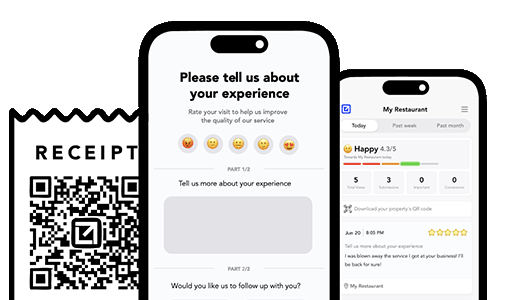Retail Isn’t Just About Sales, It’s About the Second Sale
Retail success is about the second sale. Learn how feedback drives repeat visits.

TLDR: A single bad review might not seem like a big deal, but for local businesses, it can have outsized consequences. One 1-star rating can drop your overall score, scare off dozens of potential customers, and drastically reduce your visibility in local search results. Worse, that negative impression sticks around, long after the issue has been resolved. This article breaks down the real-world cost of a single bad review, from lost revenue and decreased foot traffic to lower conversion rates and missed opportunities. It also outlines where most of these reviews come from, small, preventable friction points, and how businesses can stop them at the source. The key is to catch customer dissatisfaction before it goes public, by prompting honest feedback during or right after the visit. Tools that help you do this, like feedback QR codes, private comment cards, or real-time alerts, can be the difference between a 5-star rating and a public complaint. If you want to protect your reputation and revenue, it starts with listening before customers leave.
Let’s start with the numbers. Research shows that just one negative review can drop your conversion rate by as much as 30%. That’s not just a few missed sales, it’s a major blow to your business’s financial health. Especially in industries where a single customer might represent hundreds or thousands of dollars in lifetime value, one bad review can equal thousands in unrealized revenue.
A 1-star review can also drag down your average Google or Yelp rating, which many customers use as a primary filter when choosing where to go. If your score drops from 4.6 to 4.2, that’s enough to shift you from a “great” option to a “maybe later.” And when you’re up against competitors with higher scores, that small gap can be the deciding factor that sends customers to them instead.
Human psychology makes negative reviews feel louder than positive ones. This is called the negativity bias, our tendency to pay more attention to bad news. It’s why one bad dining experience sticks with you more than five decent ones.
When a potential customer checks your business listing, odds are they’ll read the worst reviews first. It doesn’t matter how many five-star reviews you have, one detailed, emotional 1-star story can dominate perception. You may have moved on, resolved the issue, or even changed ownership, but the digital footprint remains.
What does this look like in practice? Say a review goes live about a rude employee, long wait, or dirty restroom. It doesn’t just cost you that one customer, it also scares away everyone who reads it. You might not notice the drop right away, but over time, it adds up: fewer calls, fewer walk-ins, fewer opportunities to close a sale.
This also affects your visibility. Platforms like Google and Yelp factor in review freshness and volume. Negative reviews with no recent positive updates can make your business appear neglected or in decline. Worse, a poor rating can deter potential partners, media features, or local event invitations.
Here’s the good news: most 1-star reviews aren’t about huge problems. They’re usually about things that feel small, but weren’t addressed. Maybe the coffee was cold, the staff was dismissive, or the return policy wasn’t clear. What these situations have in common is a lack of response in the moment.
The majority of customers won’t complain to your face. They’ll smile, leave… and write about it later. That’s why bad reviews are often surprises. It’s not that the issue wasn’t there, it’s that no one caught it in time.
The key is creating space for customers to be honest, before they go online. A QR code sign by the register that says “Got a minute? Tell us how we did” can make a massive difference. It’s low-pressure, fast, and lets people vent directly to you.
Follow-up texts, thank-you emails with feedback links, and even comment cards all give customers a place to be heard. When they feel like someone’s listening, they’re far less likely to escalate things to the public. And if someone is unhappy, an instant alert means you can reach out and resolve it fast.
Instead of guessing what customers think, smart businesses use tools that collect feedback in real time. These systems alert you to issues the moment they happen, so you can fix them before they spiral.
You can also use these tools to guide happy customers toward leaving a public review, turning what could’ve been a silent visitor into a loud advocate. And with better internal feedback, you can refine your service, train your staff, and ensure every visit is better than the last.
One bad review might cost you a thousand dollars. But one piece of honest feedback? That could save you ten times that.

Bad reviews can scare away potential customers. Intercept feedback in real time with VisibleFeedback.

Austin Spaeth is the founder of VisibleFeedback, a simple tool that helps brick-and-mortar businesses intercept negative reviews before they go public. With a background in software development and a passion for improving customer experience, Austin built VisibleFeedback to give business owners a frictionless way to collect private feedback and turn unhappy visitors into loyal advocates. When he’s not working on new features or writing about reputation strategy, he’s probably wrangling one of his six kids or sneaking in a beach day.
Whether you have no reviews, bad ones, or great ones, we’ll help you turn your feedback into growth.
No credit card required.
⛨ Trusted by over 137 local businesses like yours